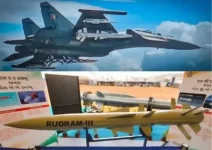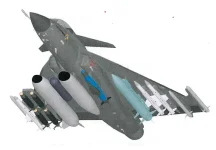
DRDO successfully tested its first indigenously developed air-launched ballistic missile (ALBM), RudraM-II, on May 29th. This achievement marks a significant advancement in India's military capabilities and poses a potential threat to Chinese assets in Tibet.
Launched from an Indian Air Force Sukhoi Su-30 MKI fighter jet off the coast of Odisha, the missile met all objectives, validating its propulsion system, control, and guidance algorithm. This recent test follows a previous successful launch earlier this year, further solidifying the missile's reliability.
The RudraM-II is part of the RudraM series of missiles, which includes anti-radiation missiles (ARMs) designed to target enemy radar systems. While the RudraM-I is solely an ARM with a range of 180 kilometers, the RudraM-II and the future RudraM-III are ALBMs with ranges of 300 and over 600 kilometers, respectively. Both missiles will have variants equipped with anti-radiation and infrared seekers, allowing them to destroy radars and heavily fortified bunkers.
With their high speeds, quasi-ballistic trajectories, and low cost, the RudraM missiles are ideal for targeting Chinese static infrastructure in Tibet, such as airfields, bunkers, radar stations, tunnels, and ammunition depots. These assets have proliferated in the region since the 2020 standoff at the Line of Actual Control (LAC), and the RudraM missiles offer a cost-effective alternative to the BrahMos missile for targeting them.
ALBMs are becoming increasingly popular among modern air forces due to their affordability, ease of manufacture, and high survivability against air defense systems. They are cheaper than cruise missiles and their speed, maneuverability, and quasi-ballistic trajectory make them difficult to intercept.
Examples of ALBMs in use include the Russian Kh-47M2 Kinzhal hypersonic missile, the Israeli Rampage and ROCKS missiles, and now India's RudraM-II. These missiles are often modified versions of existing missiles or rockets, adapted for air launch with enhanced guidance systems.
The Indian Air Force (IAF) already operates both the Rampage and ROCKS missiles and is looking to acquire them in larger quantities and potentially manufacture them in India.
The development of the RudraM-II missile is a significant achievement for India's defense industry and a potential game-changer in the region. It adds a new dimension to India's military capabilities and could deter potential aggression from China. As India continues to advance its missile technology, the implications for regional security will undoubtedly be closely watched.



